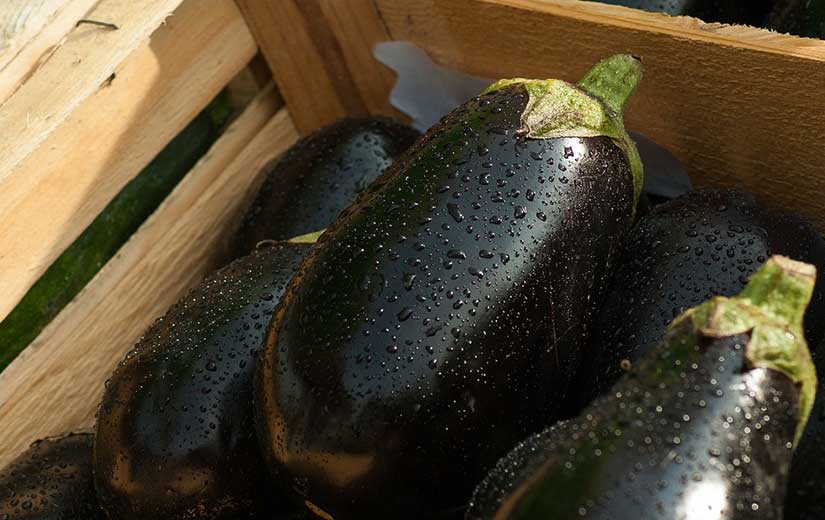When to sow eggplants?
The eggplants sow from the end of February to the month of June depending on the region and climate. This annual herb, which comes from Asia, actually needs sweetness to germinate. It is therefore expected that the jellies are passed, the ideal temperature being 20 ° C to 25 ° C.
We favor the hot sowing from the end of February to the end of April, and we reserve the sowing in place in May / June. It should be noted that if eggplants flourish well in the garden in the south, we prefer to grow under glass in the rest of France.
Which varieties to choose?
The most widespread variety in France is undoubtedly the Barbentane. Early, it is distinguished by its dark color, almost black. Supporting a cooler climate, it is easily grown in the garden. It is also one of the few aubergines whose flesh resists freezing.
You can however vary the pleasures by sitting down to other varieties:
- The Violet of Florence : this round and ribbed Italian variety with a pink and purple color is ideal for cooking stuffed vegetables. Apart from the south, it will be cultivated under shelter;
- Theeggplant from China : these fruits, finer and longer, wear a beautiful purple dress;
- The Mini Eggplant : as its name indicates, these fruits are small, and they wear a dress of a beautiful dark purple;
- TheJapanese eggplant : this variety is easily recognized by its streaked dress of purple bands.
If you like to think outside the box, opt for White round egg. This variety takes its name from its fruit, whose shape and color evoke an egg. If these fruits are tasted when they are young, it will be chosen primarily for its decorative aspect.
What to do before sowing eggplant (preparation, etc.)?
Eggplant is greedy: she enjoy a rich soil. It is therefore necessary to amend the land generously (manure or mature compost). It also requires a loose and light soil. Before sowing, it is therefore essential to work the soil at the fork for 30 cm.
Just before sowing, it is essential to prepare a good layer of substrate: mix 2 parts of potting soil for 1 part of soil. Allow some extra substrate to cover the seeds.
How to sow them?
Hot sowing
To take advantage of a longer harvest period – or in the cooler regions – we opt for a hot sowing. You can of course sow in a heated greenhouse or in a mini greenhouse heater. It is also possible to do a box sowing, which you will simply place at home, in the light and near the radiator.
Whatever type of shelter you choose, the technique is the same:
- If you choose to sow in a box, start by adding a layer of gravel at the bottom to promote drainage;
- Fill the box or buckets with sown potting compost;
- Place the seeds: 1 every 3 cm in a box or 3 to 4 per cup;
- Cover with a thin layer of potting soil, preferably sieving;
- Water in very fine rain (ideally by spraying the seedlings rather than the watering can).
If you chose the bucket crop, select the strongest shoots to keep only one per bucket.
When the plants are at least 15 cm long and have 3 to 4 leaves, you can transplant them to the garden or pot.
Seeding in place
If the climate is mild, you can proceed to a semi in place, under chassis.
- Draw lines 50 cm apart;
- Place the seeds in a 3-inch pouch;
- Cover with sifted potting soil;
- Water in very fine rain (ideally by spraying the seedlings rather than the watering can).
As for a hot sowing, it will be necessary to lighten in order to keep only one plant.
Where to plant eggplants?
Eggplants need warmth and light, so we will choose very sunny location. They will adapt well to the neighborhood of the beans. However, it will be kept away from the potato, regularly attacked by the Colorado potato beetle: this insect particularly likes eggplant, and it would soon attack it.
How to maintain them?
Eggplants do not like competition. It is therefore essential to hoe and weed regularly. You can opt for mulching, which will save you this work while optimizing watering.
To produce more generous fruit, be sure to remove the secondary stems. Eggplant must be cut. Pinch over the second flower. When new stems appear, pinch each of them above the second flower again.
How to water the eggplants?
Eggplants need a generous watering, but she is vulnerable to Downy Mildew. Watering therefore says to be well dosed. In the greenhouse, it will be watered once a week. In the kitchen garden, the frequency may be higher, depending on the climate. The ideal will be to opt for drip. Otherwise, choose a watering in the evening.
Harvest Eggplant: When and How?

Aubergines are harvested when they are young. Once mature, the fruit effectively loses its taste: it is full of seeds and its flesh is particularly bitter.
Eggplant is difficult to keep for more than a few days in the vegetable crisper of the refrigerator, it will be harvested preferably to consume it in stride. You can also cook it before freezing it.
Eggplant diseases and what to do?
The Colorado potato beetle
The Colorado beetle is fond of eggplant, and its larvae soon devour the foliage. Nettle manure is effective enough to protect plants. In case of invasion, opt for a pyrethrum treatment.
Mildew
Eggplant is frequently affected by downy mildew, which thrives well in a hot, humid environment. We act first in prevention, by adopting a few simple actions:
- Plants well spaced;
- A precise watering, foot, drip or evening;
- A careful mulching.
You can opt for a treatment with Bordeaux mixture in addition.
Powdery mildew
Like mildew, powdery mildew likes warm, humid environments. In case of awkward watering and water spray on the leaves, it can touch the eggplant. But she is able to resist it well, and it is usually sufficient to eliminate the affected parts to contain the disease.
Even more plantations:









